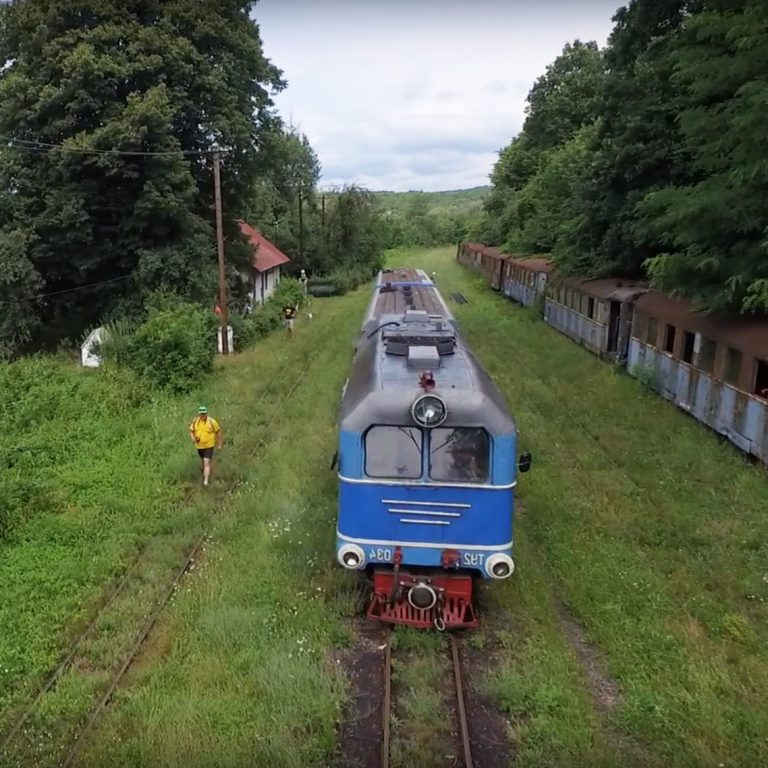— How much for palynka (palynka (palenka) is a name used in Zakarpattia for hooch, which is usually fruity and very strong — translator)? — Denys asks a lady who has put plastic bottles all over the railroad tracks. After some haggling, he buys some palynka as well as tomatoes and cheese. Finished with shopping, we wait for the train. —Where exactly will the train pass? — I ask. — You will see it right here, — says Denys and points at his feet. We are standing in the middle of the market and it is hard to believe that there are railway tracks just under our feet. The train starts to move, all the people around are bustling and removing everything from the tracks. — The train will manoeuvre a bit and will leave in the opposite direction, — says Denys.
Denys Dobra is one of those people who selflessly work on the preservation and restoration of the Borzhava narrow-gauge. He is a founder of the non-governmental organization “Borzhava initiative”. Denys is 47 years old and was born in the village of Imstychevo, which is in the Irshava district. He has been taking care of Borzhava narrow-gauge for over 15 years.
— The railway goes through my village. I remember how I travelled in these old carriages. I remember how I took this train from Irshava to Imstychevo when I was in the ninth grade at school. Everything started in 2000 when we organized the first tourist trip. We rented a draisine, which is “retired” by now. We went from Lukiv to Berehove and simply made a photographic report. Afterwards, there was a small exhibition for friends. At that time digital cameras did not exist and we were taking the usual film photos. I still have that tape somewhere.
The train is moving very slowly. From time to time the driver whistles at people to force them to get away from the tracks with all their stuff as soon as possible. Here, the train has to turn around and pick up passengers, and then it will immediately go to Irshava in the opposite direction.
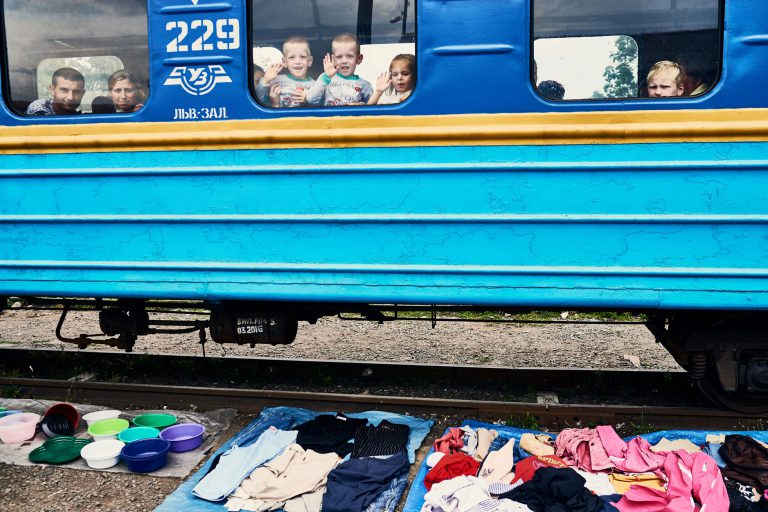
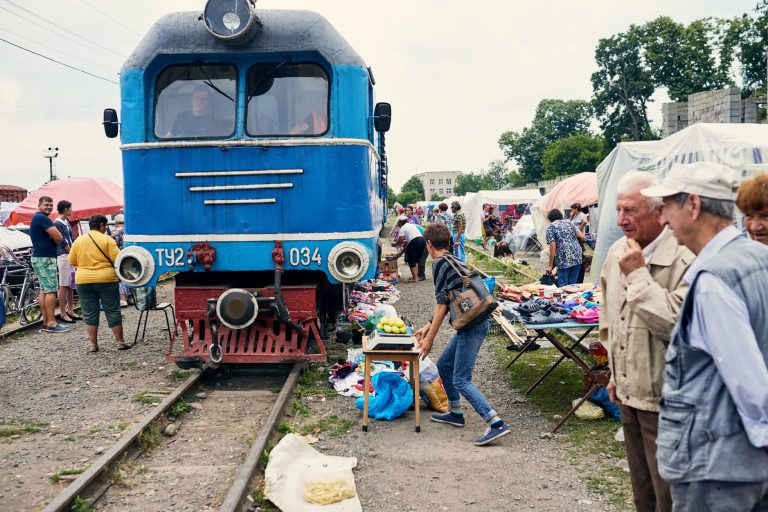
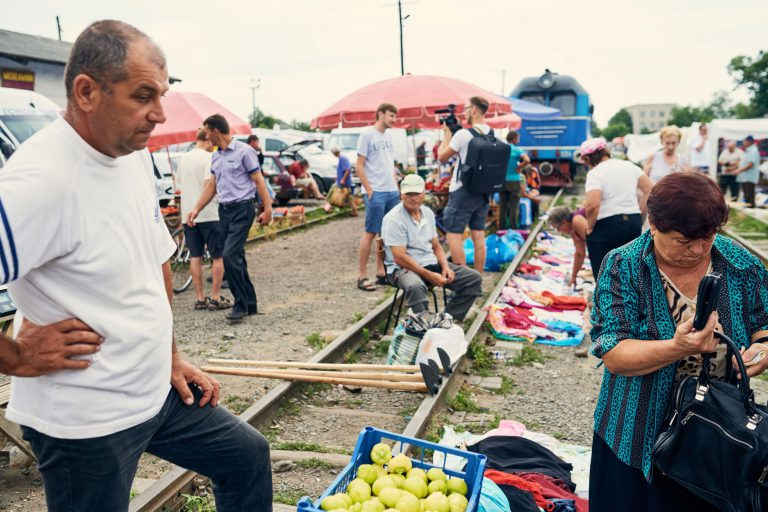
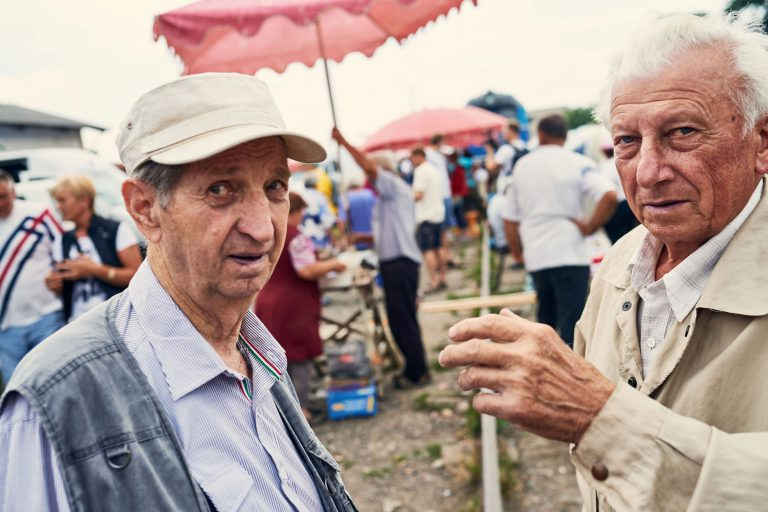
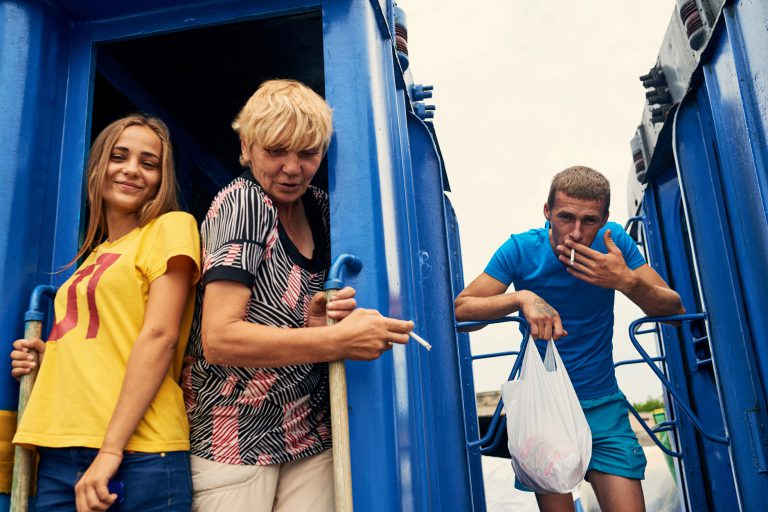
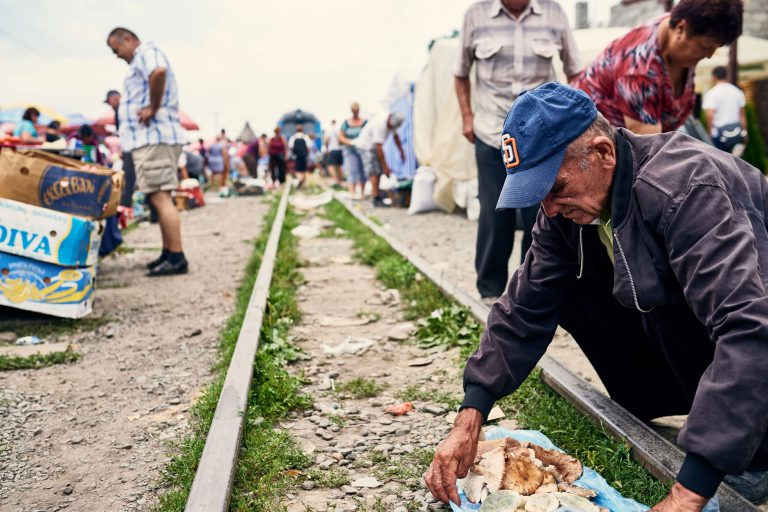
slideshow
Here, just near the train station, is a market, just like in old times. “Market — train station” is the main artery of the city where all trade routes intersect with the transport routes as literally as you can imagine. It looks like colourful photos from Sri Lanka, Vietnam or India where locals decided not to create a special place to sell things from their own gardens and backyards and began to sell exactly where they got off of the train. The train is manoeuvring among the passengers with the speed of a snail, between cities it goes slightly faster — at 15 kilometres per hour.
— You know, there are no facilities in the carriages. We have a joke that if you get out from the first carriage, you will have enough time to do your business in the bushes and jump back into the last carriage. The point of this joke is that there are no other carriages between the first and the last carriage because there are only two of them.
People often call Borzhava narrow-gauge “Antsia Kushnytska” or, occasionally, “Zhuzhika”. Antsia is one of the few narrow-gauges still operating in Ukraine and one of the three narrow-gauges which are part of the Ukrainian Railway (UkrZaliznytsia). The other two are Haivoron narrow-gauge and Polissia narrow-gauge. People have given a lot of names to the last one — “Kukushka” (cuckoo), “Polissia tram”, “Transpolissia highway” or “Poizdok” (small train). The width of all Ukrainian narrow-gauges is 750 mm. Also, there is Vyhoda narrow-gauge which is better known as “Carpathian tram”.
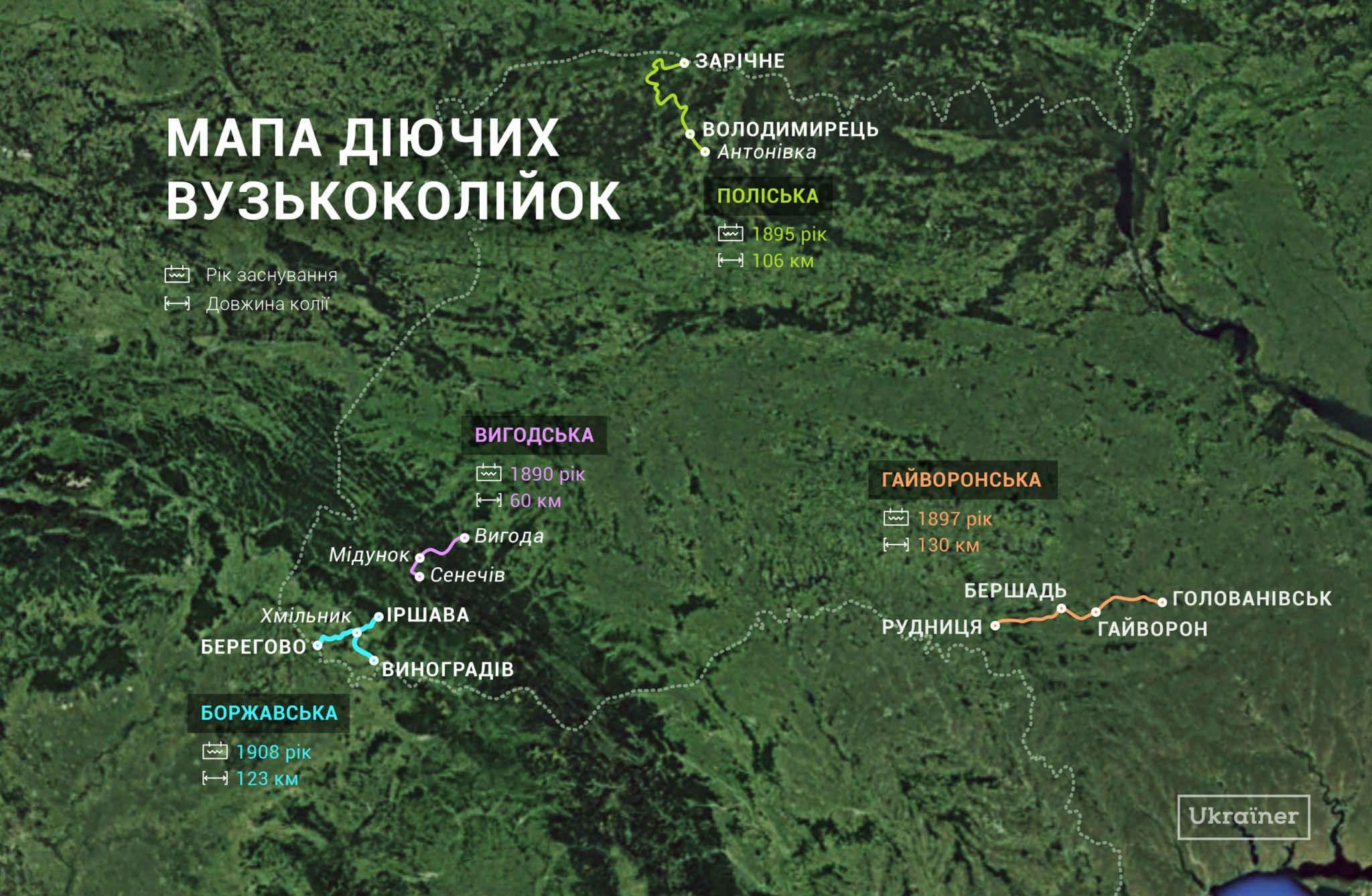
History
The total length of Borzhava narrow-gauge is 123 km. The first part has been operational since December 1908. Nowadays the most active branch of the narrow-gauge is that one that was launched last.
— According to the plan, the first part of the railway was from Berehove through Irshava to Dovhe. Why did it happen in this way? In fact, a fight was going on between the two cities — Mukacheve and Berehove. Uzhhorod became a politically and economically influential city only during the second and the third decades of the 20th century. When an idea of building a narrow-gauge railway in the valley of Borzhava river appeared, traders from Mukacheve actively opposed the construction of the railway. The trail went on for almost six years in order not to give the opportunity to build this branch of the railway, since Berehove would get a powerful and useful connection to Verkhovyna.
This narrow-gauge became one of the most important transport arteries in the region. At that time, the railway was mostly used for logging, but there was a very active labour migration of people. In other words, people from the mountain regions were going to work in the lowland by foot, and thanks to “Antsia” this problem disappeared.
Forest industry during the Austro-Hungarian monarchy had been developed using the advanced technology of that time, railroads were built all across Zakarpattia. According to archive documents, the first attempts to build the railway line in the valley Borzhava were in 1886 during the Hungarian kingdom. However, only after 18 years, in February 1904, the constituent assembly was convened in Mukacheve, and this assembly can be regarded as a birthday of Borzhava narrow-gauge.
Commissioning took place in December 1908, but before then there were almost two decades of judicial and organizational red tape. That construction process by itself was extremely fast for those times.
— The scope of this project, for that time, is hard to imagine nowadays. Every time I compare it with the invention of Pentium processors, because from that moment the development of computer technology dramatically went up. Before, people travelled to the fair from Verkhovyna to Berehove for a day and a half, but with the appearance of the train, the travel time decreased to 3 hours. Construction of the railway gave a big push to all Borzhava valley, because the railroad goes along the banks of the Borzhava river, which extends for 104 kilometres, and in fact, the whole area has got very efficient transport infrastructure.
In winter 1908 the railway line from Berehove to Dovhe was officially put into operation. During the first fifteen years of existence, Borzhava railway was privately owned and existed in the form of a joint-stock company, which was called BGV — Borzsavölgyi Gazdasági Vasút (Economic Railroad of Borzhava Valley).
— When I ask people about their opinion on who could build this railroad, usually they reply that it was some rich man, an oligarch or government. And I say no. In fact, for the construction of the railway in 1904, a joint-stock company (JSC) was established, which consisted of the communities of the settlements on the territory through which the railroad runs. Each settlement had delegated one representative, and that’s how the company was founded. Afterwards, this JSC, supported by the Government of Hungary, asked the bank for a loan for the construction of the track. I believe that this is an important experience for certain projects in modern Ukraine i.e., there is a public initiative, there is governmental support and there is a financial institution that works with all this.
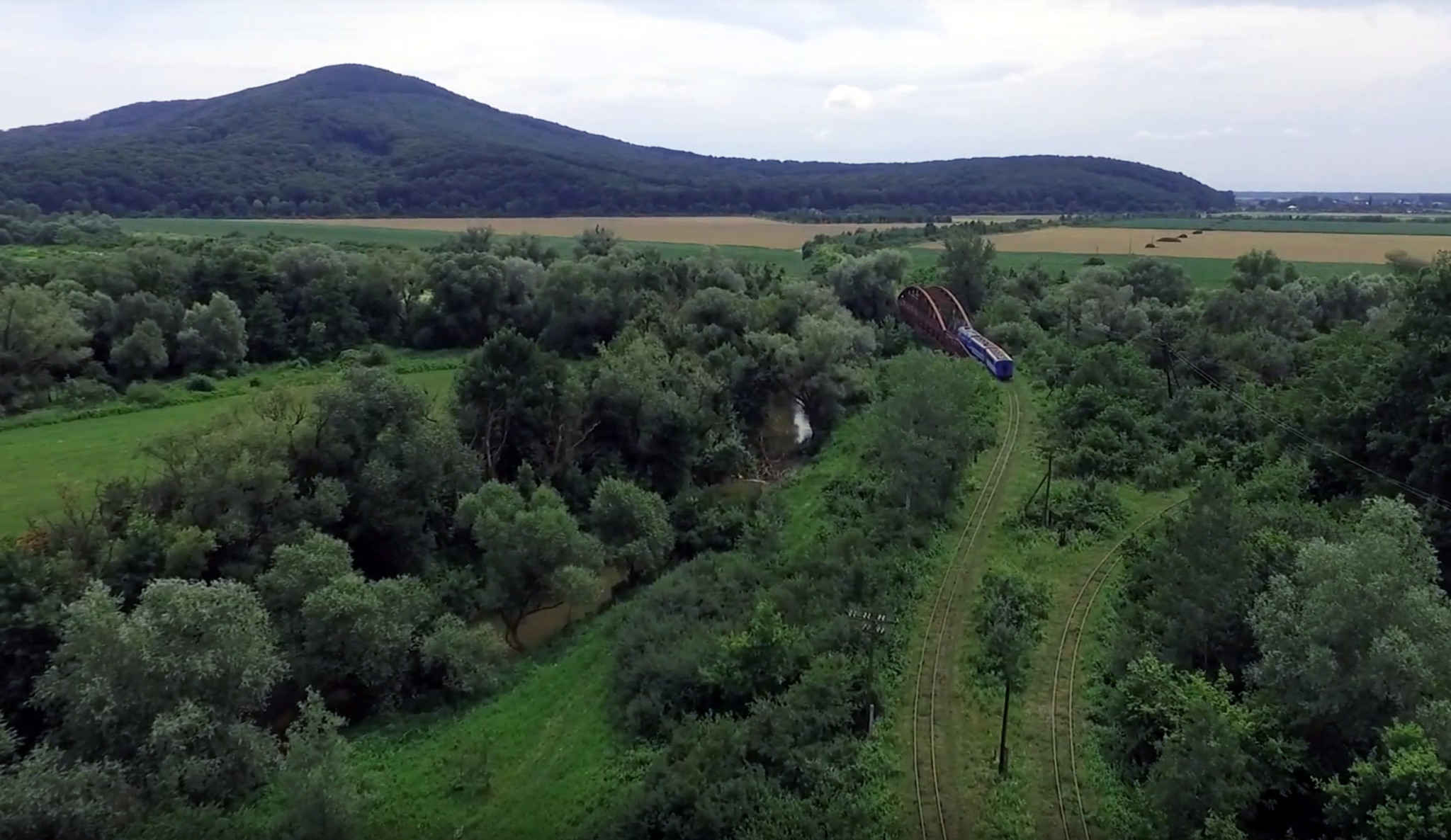
The network of the railroads of Borzhava narrow-gauge was made according to Bosnian standard and had a width of 760 mm. The maximum incline was 33% and the minimum radius of the track was 100 meters.
In the beginning, the passenger traffic was carried only on two parts of the railway, while the others were under active construction. One of the important factors was the spring flood, which temporarily led to a reduction in train traffic. Freight traffic began a bit later and was associated with a gradual adjusting of trade contacts between lowland and mountain areas.
— In 1889 the regular World Exhibition took place in Paris. Its main symbol was the Eiffel Tower. At this exhibition, engineer Paul Decauvillle presented a narrow-gauge railway system as the most economical model of the fast construction of the qualitative transport infrastructure. At this Paris Exhibition, a demonstration was made, showing the process of fast construction for a railway that was three kilometres long and consisted of four stations. This project was implemented by Swedish entrepreneurs in Gothenburg city the next year. By the way, this railway is still operating today. We can compare the years of the Exhibition in Paris (1889) and commissioning of Borzhava NGR (1908). The difference is only 19 years! Can Zakarpattia present, today, some similar historical monument of a technical nature in the same pro-European connection?
— At that time it was the railway of the future. Such narrow-gauges appeared all over Europe at the same rate as new smartphones models appear nowadays.
After the end of the Second World War, the Soviet government came to Zakarpattia and the railway reform was started. At that time the most important task was to replace the European type railroads with the wide railroads, which were the standard of the railways in the Russian Empire and later in the USSR. Besides this, a few narrow-gauges were “re-sewed” to the Soviet system — from 760 mm to 750 mm. The transition for broad-gauges was completed within just two years, while narrow-gauges were completely switched to the new standard only in 1950.
At the beginning of 1926, the length of Borzhava narrow-gauge was 107 km and the railroads were extended to 123 km after the war. However, there was no passenger traffic on many parts of the railroad for a long time. Many sections of the railroad, as well as stations and junctions, had been dismantled a long time ago.
Numbers
19 years had passed between the invention of the construction technologies of the narrow-gauge and its appearance in Zakarpattia.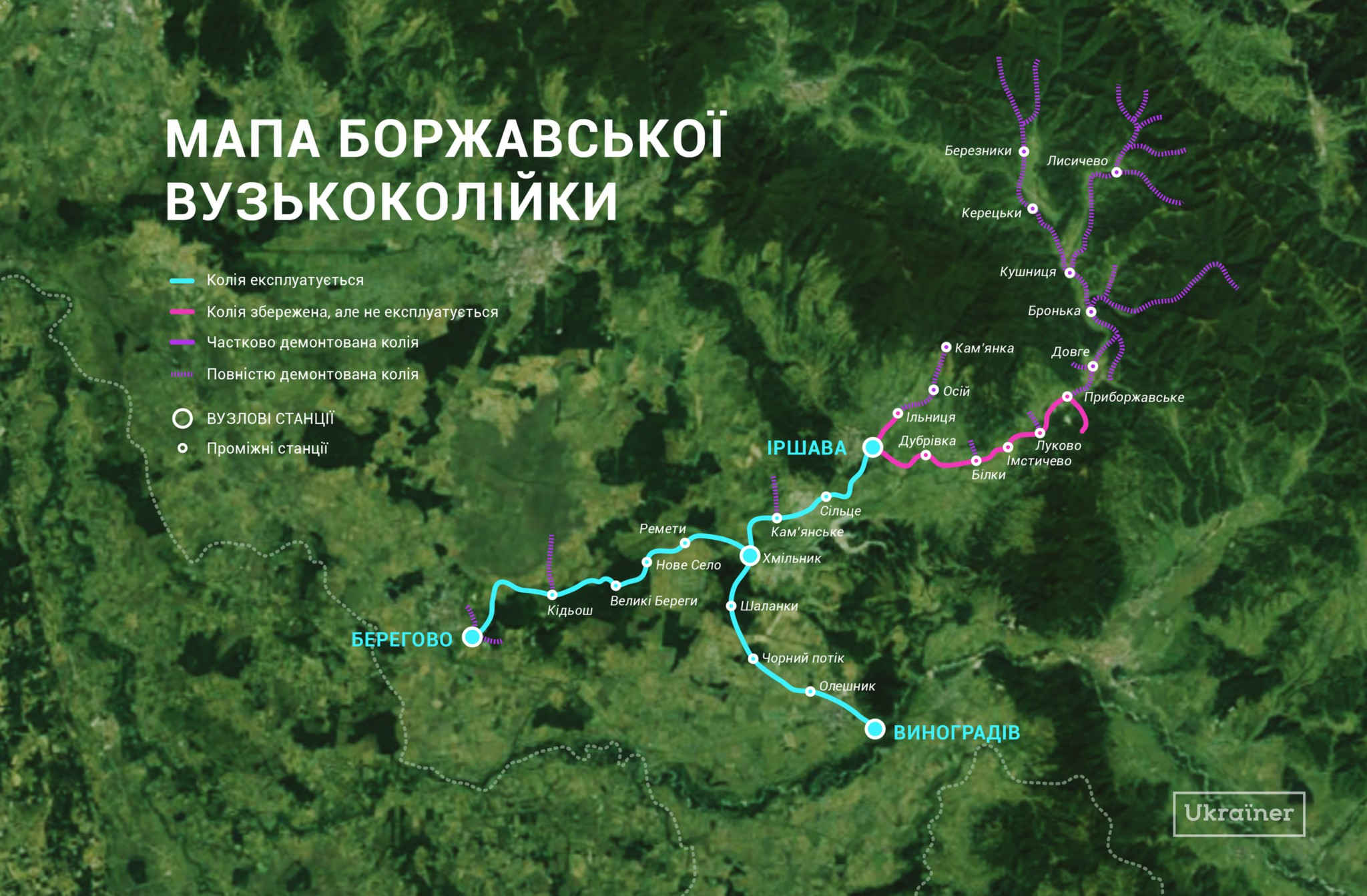
The current situation and role of UkrZaliznytsia (Ukrainian Railway)
In Soviet times the narrow-gauge railway was actively used for the transportation of the employees of enterprises of Irshava district. Forest combines, factories for building materials, furniture factories, factories for abrasives, enterprises of the food industry, engineering factories and even a coal mine were using the narrow-gauge railway.
In 1991, when Ukraine became independent, the history of the independent Ukrainian railway began. After UkrZaliznytsia became an owner of the narrow-gauge, its development stopped completely.
The peak of all problems here happened in 1994 when there was a crisis with the supply of fuel, which was caused by the lack of orders for freight transportation by the companies in the region, which had gone bankrupt. In the days of the successful operation of the railway, it was loss-making, and in times of crisis, passenger traffic stopped almost completely. Passenger traffic was operational only on the segment between Vynohradiv and Khmilnyk, where the narrow-gauge railway was the only effective passenger transportation, even though its speed was 15 km/h.
— An interesting story happened. In 1993, Ukraine was in a serious crisis with fuel. In fact, all public transport stopped. Buses did not go, because there was no petrol. The railway connection to Irshava from Berehove stopped as well. Vasyl Petrovych Kotsan from Velykyi Rakivets, as a representative of local government, decided to solve this problem. He was the local representative of the president. At that time there was such a thing – a representative of the president. He was not the Chief of Staff, did not work in governmental organisations, nothing like that. He was just director of the state farm in the Velykyi Rakivets. Vasyl Petrovych was the first who asked railroaders to save the railway connection from Berehove to Irshava. When the buses did not go, people were travelling by train, and in this way, the railway on this segment was saved.
Currently, passenger traffic is available only from Vynohradiv to Khmilnyk. The rest of the railroad is still used for freight transportation. Diesel locomotive TU-2 (made in 1972) operates for passenger traffic. The carriages are a bit more modern (made in the early 1980s).
— Activists have worked hard to organise tourist trips during weekends, but it is quite difficult to reconcile with the interests of the railway, because the railway always asks impossibly high prices…
— We are continuously having a discussion with the authority of UkrZaliznytsia and the Ministry of Infrastructure. The main problem is that today’s train speed is only 15 kilometres per hour. If the speed is increased, the train will use significantly less fuel, and the railway will be faster than the bus transportation. But unfortunately, UkrZaliznytsia does not care about saving money and efficiency, and also does not work on upgrading and restoring the carriages. Here we have old vintage carriages. But they want to cut it for some scrap metal. The railway has decided that these carriages are not “alive” anymore. But the Poles come here, kneel and cry: “Give us one carriage, sell it. We can repair one for you, but instead, we will take one for ourselves.” These carriages are Polish, and the Poles, unlike us, honour their history.
— In 2004 I went to Kirpa (Heorhiy Kirpa — the minister of transport and telecommunications of Ukraine at the time — author). I was asked to pay three thousand dollars just to get there. But it did not mean anything and nothing was guaranteed. I was only allowed to wait at reception. It was possible that nothing would happen. It was possible that I would go there and they would just offer me a coffee… Very cool, right? You pay 3000 just to drink coffee at the reception… I do not want to speak ill of him, because many things in UkrZaliznytsia have been positively changed when he was the minister. But, you know, there is a tradition in Ukraine that you have to hide behind your authority and “approach the person” only through payment. And everybody was doing this.
Plans and prospects
Denys believes that the most important stage of the development Borzhava narrow-gauge was its recognition as a historic monument of local importance on the territory of Irshava district. Unfortunately, this decision could have been made decades before, and the current situation would have been much better.
Nowadays, using the experience of neighbouring Hungary, we should ban the destruction of rolling stock — locomotives, carriages and railroad facilities. The next step has to be studying the propositions and possibilities of using the narrow-gauge in the organization of tourist traffic. But in any case, the part of the railroad from Vynohradiv to Khmilnyk should serve as transportation for the inhabitants of the surrounding villages. In this area, even the purchasing of buses and their maintenance will not replace the railroad, because there are no quality roads. Still, the roads are not paved.
Numbers
3000$ Is the amount that was asked for in 2004 to get an appointment with the former Minister of Transport.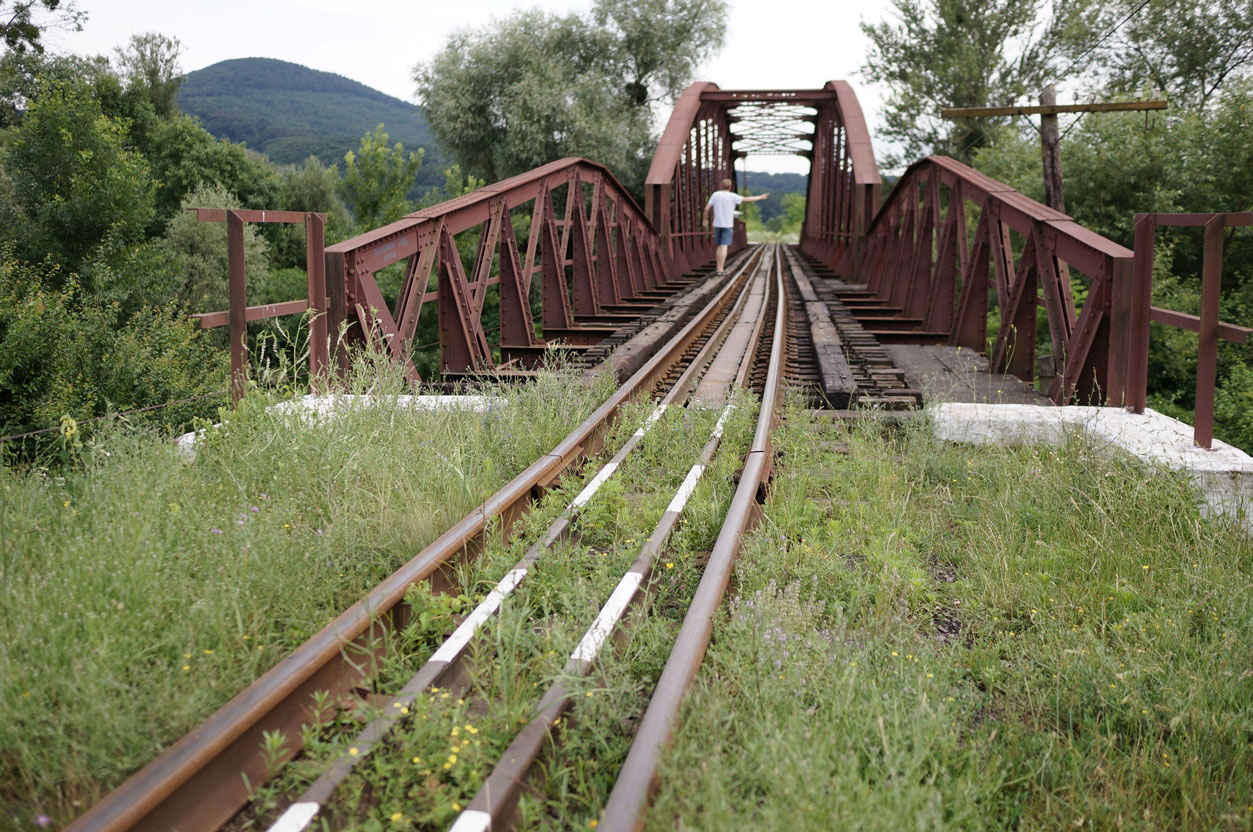
— Local activists have offered UkrZaliznytsia to rent the narrow-gauge railway for a small fee on the terms that the railway will be maintained and operated.
For example, in neighbouring Poland from 2009 to 2012 part of the Bieszczady Forest Railway was reconstructed, which has nearly 40 km of track, rolling stock and related infrastructure such as stations and cafes. For this reconstruction, about 550 000 euros was spent, which is almost 6 million hryvnias. But UkrZaliznytsia says that they need 8 million for the annual maintenance of Borzhava narrow-gauge. This number, according to Denys, is a rough estimate, because with such an amount of money it is possible to make quality changes all the time.
— We are ready to cooperate with Polish colleagues and learn from their experience. It would be very useful for us. Then, we can create a joint-stock company of the Borzhava narrow-gauge railway and foundation “Borzhava narrow-gauge”. We can do all this together with the village councils (Irshava, Berehove, Vynohradiv and Zakarpattia Regional Council and Lviv railway), through which the track runs. To the founders of the joint-stock company, we would also add the local authorities and municipal enterprises. The authorities must take over partial support of the activities of the company.
Thus, the company would indirectly take over control of the investments and modernization of rolling stock. All this would make it possible to provide quality transportation services and work towards a gradual increase in profitability. Even though this project requires significant state support, it is very promising. Because in the future it will help to attract additional resources, including those from abroad.
Denys is fluent in several languages and accompanies tourist groups, which have started to come here quite often. Small festivals with Borzhava narrow-gauge fans take place here sometimes.
There are a lot of fans of the narrow-gauge. Some locals speak about it with some special warmth. In particular, Volodymyr Kryshenyk, who lives in Zakarpattia, wrote the following in his memoirs about his father:
— But I remember when it was alive, when it was happy in its working state, and even very fast and impulsive sometimes. I was a child in far 1960s. Often we were trudging, firmly sitting on the rough benches in the carriage. In this way we travelled from the village of Bilky to Irshava music school. It was still better than trying to get into the bus with a big crowd. The bus was from Dovhe village and was very unreliable. Occasionally, the bus would not stop and furtively pass by. Afterwards the bus could bark and burp with all its poisonous petrol smoke.
Denys, with the community, welcomes tourists here, but at the same time, they are very concerned because they cannot provide proper, comfortable conditions to those who come here.
— For example, fifty people come to us to have a ride on the railway. One way ticket costs seven hryvnias. Let’s assume that all these people will order wine tasting, so they bring a few thousand to the village which does not have any other business. Of course, you can increase the price of the tourist groups’ transportation. Make a separate carriage, even if the tickets will cost three times more. Tourists are willing to pay, but they need at least some comfort.
Numbers
8 mil. Ukrainian hryvnias UkrZaliznytsia needs to maintain Borzhava narrow-gauge per year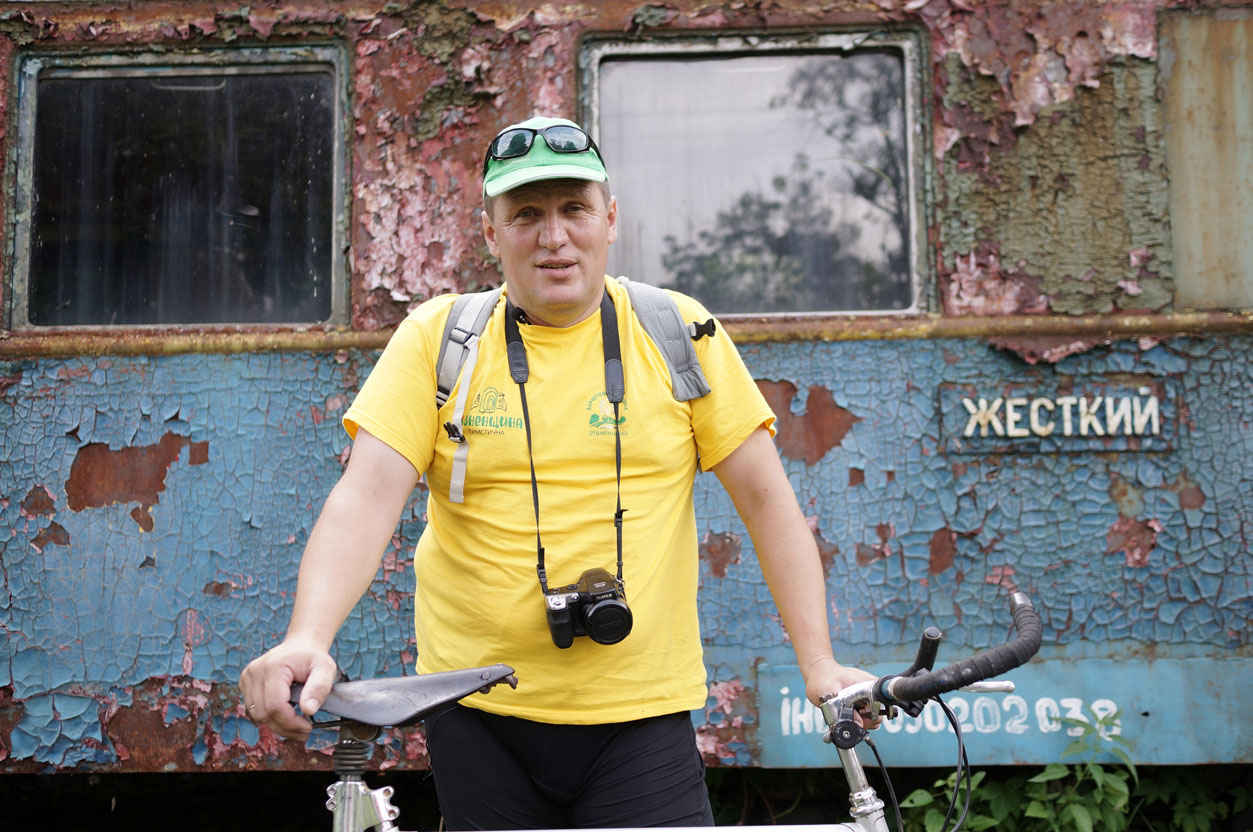
— There is a wooden freight carriage, do you see? In the spring I was trying to organise it so that this carriage would be attached to the main train which we use for the tourists. Do you know how much I was asked for it? Seven thousand hryvnias. “Pshonka-carriage”, that is used in the South-West railway and goes from Dnipro to Kyiv, costs 90 hryvnias per kilometre; and our wooden freight carriage would cost 420 hryvnias per kilometre. In fact, if the diesel locomotive goes anyway, adding one more carriage will just slightly increase the amount of consumed diesel fuel. In short, it does not matter how you count, even if you multiply everything by ten, you will get an amount that is much less than seven thousand.
We are walking through shrubs along the railroad, we cross the bridge, Denys goes on his bike. Bitsihli (bicycle in Zakarpattia) and “Anka” are his main transport. Denys confidently keeps going, overcoming all obstacles in his way. We follow him, and we fully feel the amazing energy of these places.
Despite all the troubles, Borzhava narrow-gauge keeps going. Denys is initiating many projects at the same time in order to bring people’s attention to this place. In summer and autumn, there are wine and berry tours. In winter, for Saint Nicholas Day, there is a real fairy-tail, when the ordinary train becomes festive and children come from all around. On this day, Denys dresses up as Saint Nicholas and gives presents to the children. All the other days he works as a teacher of the computer science at a school and always spends time to protect and restore the important historical landmark — Borzhava narrow-gauge, the railway of the future — the one that is forgotten by many people, and some people did not even know about it at all.

